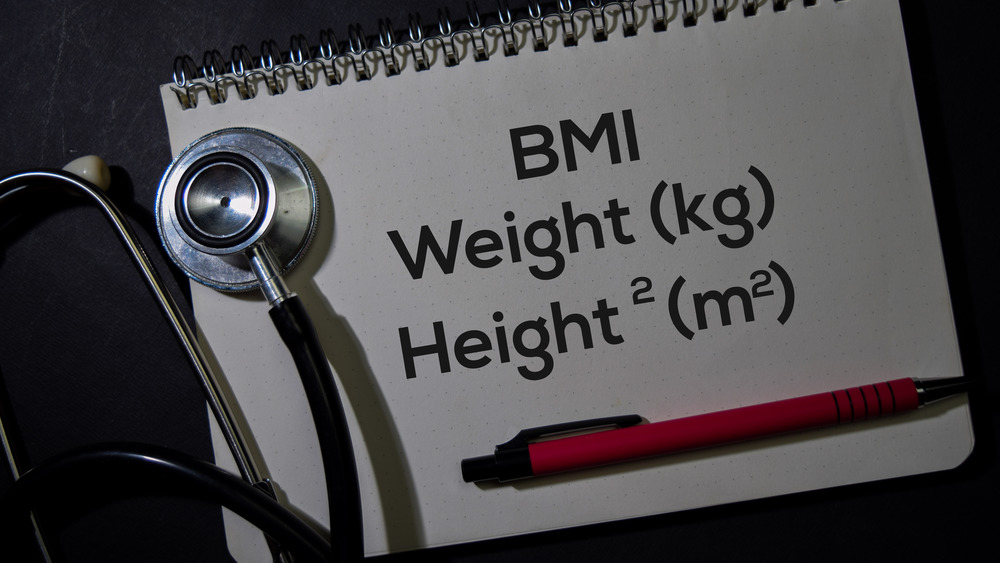BMI: Everything You Need To Know
BMI, short for body mass index, is a tool individuals and health professionals alike use to assess a person's weight status. (i.e., underweight, normal weight, overweight, obese, or morbidly obese), according to the Centers for Disease Control and Prevention. The problem is, like weight, BMI doesn't provide any information about what is or isn't happening inside the body (via Vox). While the measurement has its place, it can be misused, which may lead healthy individuals to believe they're unhealthy or individuals with concerning health problems to believe they're healthy.
The original intent for BMI around the world was as an epidemiological tool — a way to track population health and risk factors, not individual health or risk factors. In 1985, the National Institutes of Health began using BMI as a means to identify obesity, and by 1998 it encompassed all ages, sexes, and cultural backgrounds, as registered dietitian nutritionist Angela Lemond explained in an article for Everyday Health.
When BMI is used to assess potential risk factors for disease, as is done in epidemiology, it can be useful. However, when it's misused to diagnose health status, its accuracy can prove problematic, as Everyday Health highlighted. This is what you need to know.
BMI is a ratio of height and weight
You know that BMI is a measurement to convey weight status, but what exactly is it? According to the Centers for Disease Control and Statistics, "Body mass index (BMI) is a person's weight in kilograms divided by the square of height in meters." So, unlike the number on the scale, BMI factors your height into its assessment of weight status, which is certainly more helpful than ignoring the role that height has on a person's weight.
Think about it: Having nothing more than a weight, say 135 pounds, can't convey any information at all about a person's potential health status. For instance, a 6-foot, 3-inch man who weighs 135 pounds is very likely underweight and may be at risk for health issues. Convesely, a 4-foot, 11-inch woman who weighs 135 pounds may be overweight and at risk for potential health problems. By including height as a part of the BMI calculation, it becomes easier, and more accurate, to assess at a glance whether a person might be at risk for potential health issues.
There is a correlation between BMI and health outcomes
The reason why BMI is so widely used as a risk analysis tool is that it does, in fact, provide a strong correlation analysis between height and weight and body fat percentage, a study in BMC Public Health found. According to WebMD, body fat percentage is an effective way to assess underweight, overweight, or obese health status. And unlike tests to measure body fat percentage, BMI is inexpensive and easy to calculate. For doctors and patients alike, the affordability factor along with its known correlation makes it a good tool for risk assessment.
Many known health problems are associated with obesity, according to the Centers for Disease Control and Prevention. These include all-cause death, high blood pressure, an unhealthy balance of cholesterol, type 2 diabetes, heart disease, stroke, and other conditions. While BMI doesn't assess a person's levels of body fatness, it offers a quick and easy way to gain initial insight into a person's health (via WebMD).
BMI isn't a good measure for athletes
Think for a second about professional football players, power gymnasts, or wrestlers. Often, athletes in these sports benefit greatly from packing on weight in the form of muscle mass. These athletes also train and exercise for hours each week, which, as a whole, is known to improve overall health, reducing the risk of obesity-related diseases, such as heart disease and diabetes (via Centers for Disease Control and Prevention).
But when it comes to BMI, the ratio of height and weight doesn't differentiate between weight packed on as muscle or weight packed on as fat. If a 5'9" football player who has spent years building muscle for his sport weights more than 203 pounds, his BMI would be considered obese, according to a chart provided by the CDC. However, his body fat percentage would likely (and appropriately) place him in a "good" or "excellent" range. And as pointed out by Everyday Health, athletes tend to have higher BMIs, but these higher BMIs may not be unhealthy.
The standard BMI scale doesn't apply to all populations
One big problem with using standard BMI calculations to diagnose health risk is that, originally, most studies were performed in Europe and the United States, and did not account for Asian populations. According to a 2004 study published in the Lancet, a World Health Organization (WHO) expert determined that "Asian populations have different associations between BMI, percentage of body fat, and health risks than do European populations." In other words, you can't directly apply the same health risk assessments based on BMI to individuals everywhere. In fact, certain health risks appear to increase at a lower BMI and body fat percentage within the Asian population than for those with a European background.
The WHO consultant pointed out that increased levels of health risk based on BMI varied in different Asian populations, making it difficult to determine a more accurate BMI scale. As such, no such "improved" scale has been determined, and the standard BMI scale continues to be used worldwide. However, the study advised health officials to alter definitions and health risk assessments based on their populations.
Older adults don't fit into the standard BMI scale
Health risks associated with body fat percentage change with age (via Everyday Health). As such, you can't fully assess health risk the same way for a person who is 45 years old and a person who is 85 years old. In fact, in older populations (those over 65), low BMIs and body fat percentage are actually associated with increased health risks. There are likely a number of reasons for this. For one thing, a low body fat percentage might signal the presence of a disease. Or it could indicate nutritional or lifestyle deficits that lead to a loss of muscle and bone mass.
As written by Angela Lemond, a registered dietitian nutritionist, for Everyday Health, "Those with a higher BMI tend to carry more pounds of muscle compared with those with a lower BMI, which has a protective effect in terms of overall functionality, fall risk, and overall immunity." So while adults 65 and under are considered "normal weight" up to a BMI of 24.9, per the CDC, a 2014 study published in the American Journal of Clinical Nutrition found that adults over 65 tend to have the lowest risk for early death with a BMI of 27.
Children and teens shouldn't use the adult BMI calculator
Children and teens can't be held to the same health risk assessment categories as adults. It's not hard to imagine why, as children and teens are growing and not fully developed. And as they continue growing and developing, their height, weight, muscle mass, and fat deposits change accordingly, as the Centers for Disease Control and Prevention (CDC) explained.
While there are some standard expectations for when children and adolescents will go through different growth spurts, these vary widely from one child to the next. As such, the CDC provides another way to use BMI for children and adolescents, first determining the ratio of height and weight, then using a percentile assessment (there's an easy calculator for this) for sex and age to determine where the child falls in relation to other children of the same age and sex.
This is important because, like adults, children may be at greater health risks if they're underweight or obese. That said, because of continued growth and sex-related changes, it's important to assess health risks based on comparisons with other children in the same age and sex categories. Children who fall between the "5th percentile to less than the 85th percentile" for age and sex are considered to be at a "healthy" BMI.
BMI does not measure body fat percentage
It's a common misconception that BMI is the same thing as body fat percentage. While BMI correlates strongly with body fat percentage on an epidemiological level, BMI itself is simply a ratio of height and weight. As an article on CNET pointed out, body fat percentage actually provides a reasonably accurate measurement of how much fat mass and fat free mass (consisting of bones, muscle, and other body tissues) your body contains. A true body fat percentage measurement provides a more accurate health risk assessment than BMI, regardless of age or population.
As Karen Andry, a registered dietitian and bariatric coordinator told Piedmont Healthcare, "[BMI is] not the best indicator of how much body fat and how much muscle one has." So why isn't body fat percentage used more often? It's not as quick, easy, or inexpensive as BMI (via WebMD). But if you're interested, you can ask your local gym or hospital to see if they offer body fat testing in the form of caliper readings, underwater weighing, or DXA scans — many such locations do provide these services for a nominal fee.
It's possible to have a normal BMI with a high body fat percentage
Having a "normal" BMI doesn't necessarily mean you have a healthy body fat percentage. As physician Richard L. Atkinson told WebMD, it applies to "probably ... 90% or 95% of the population" — but not everyone. In fact, Scott Kahan, director for the National Center for Weight and Wellness, told the site that BMI doesn't even tell the whole story of what's going on inside a person's body. Specifically, older individuals, those who are in poor shape, or those who are sick may have a "normal" BMI, but might have high body fat percentage.
After all, there are some people who don't exercise regularly and are primarily sedentary do not put on excess weight. These people may register a "normal" BMI, but that doesn't mean everything is hunky-dory on the inside, especially if their body fat percentage is high. "Ultimately, they have similar risks as people who carry lots of body fat and have a high BMI," Kahan said.
There are other measurements that give more clues about health
One of the reasons BMI is used so frequently despite its limitations is that it's easy to assess. Most adults know their height and own a scale. And with these two pieces of information, they can use an online BMI calculator to get their number. Body fat percentage assessments, on the other hand, require special equipment and trained technicians to get an accurate reading (although home-based body fat percentage scales are a reasonably affordable and relatively accurate option, if you're so inclined).
But the reality is, there are other easy, inexpensive assessments you can perform that are at least as accurate as BMI at assessing health risk, if not more so. According to WebMD, waist circumference and waist-to-height ratio are both good ways to check your own potential health risks. All you need is a tape measure in order to try these assessments. The reason why waist circumference is a helpful indicator is because health risks increase with increased waist circumference regardless of BMI, as pointed out by Mayo Clinic.
BMI is used as a guideline for how much weight pregnant women should gain
Pregnancy weight gain can be tricky. You know you need extra calories for the baby, but there's always questions: Am I gaining too much, or not enough? What's the right amount? Of course, as with everything, the "right" answer varies from person to person, and it should always be a conversation you take up with your doctor. Nevertheless, BMI is used as a general guideline to help women (and their doctors) determine how much weight should be gained.
According to the Centers for Disease Control and Prevention, individuals with an "underweight" BMI before pregnancy (a BMI under 18.5) should gain a little more weight than other pregnant women, with an amount between 28 and 40 pounds. Those who fall in the "normal" category pre-pregnancy (BMIs of 18.6 to 24.5) should aim for 25 to 35 pounds, and those who are overweight (BMI of 25 to 29.9) or obese (BMI over 30) should aim to gain a little less, with suggested amounts ranging from 15 to 25 pounds, and 11 to 20 pounds, respectively.
It's possible to be perfectly healthy with a high BMI
Just because BMI is correlated with increased risks of health problems like heart disease, a person with a high BMI might, in fact, be completely healthy. Without further diagnostic tests in the form blood work or blood pressure testing, a high BMI alone doesn't tell the full story.
Scott Kahan, the director of the National Center for Weight and Wellness told WebMD that he regularly sees patients who are overweight but healthy, saying, "They're heavy. Their BMI puts them in the obesity range. And yet on every level that we look at, their health is actually quite good. Their cholesterol and blood pressure are excellent. Their blood sugar is excellent. They don't seem to have any health effects associated with their excess weight." This makes BMI a good jumping-off point for health risk assessment, but it's far from a stand-alone tool.
It's possible to be unhealthy with a normal BMI
There's an easy trap to fall into — that health can be determined simply by looking at someone. If someone appears overweight, then they probably eat poorly and never exercise, right? Or the opposite, if someone looks thin, then they probably take good care of themselves. The reality is, health is multifaceted and complex. Just as a high BMI doesn't necessarily mean unhealthy, a normal BMI doesn't necessarily mean healthy.
In fact, a 2016 UCLA study that compared BMI status and survey respondent's actual health-related markers, including blood pressure, glucose, cholesterol, and triglyceride levels, found that more than 30 percent of those with "normal" BMIs (that's the equivalent of roughly 20.7 million people in the U.S., by the way), were actually unhealthy based on other health data (via UCLA Newsroom). This once again underscores how the BMI isn't exactly the gold standard of measuring a person's health status and behaviors.
Medical professionals aren't the only ones who can use BMIs
Your doctors aren't the only ones who use your BMI as a measure of health. "Many U.S. companies use their employees' BMIs as a factor in determining workers' health care costs," a 2016 study by the University of California-Los Angeles found.
Plus, many of these BMIs are inaccurate. The study found that "54 million Americans whose BMI classes them as overweight and obese are in perfect health according to cardiometabolic measures, while 21 million whose BMI puts them in the normal category are unhealthy" (via Medical News Today). The study's lead author, A. Janet Tomiyama, an assistant professor of psychology at UCLA stated, "Employers, policy makers and insurance companies should focus on actual health markers."
The giant issue with this is that BMI, once again, isn't an accurate diagnostic tool for whole health. When used as the be-all and end-all of health, it can inappropriately affect millions of healthy individuals who happen to have a high BMI, or inappropriately overlook millions of unhealthy individuals with a normal BMI.
BMI can be a starting point for doctors to assess health
The ease with which BMI is assessed continues makes it a helpful tool for doctors. When a healthcare professional looks at BMI in conjunction with other assessments, like blood pressure, blood sugar, and cholesterol, they can use the numbers received from all tests to determine what further action should be taken to help you achieve or maintain your health-related goals.
This may include more tests, hands-on exams, or referrals to other specialists. And, as Dr. Richard L. Atkinson, physician and editor of the International Journal of Obesity pointed out to WebMD, BMI is highly correlated with obesity, and for a majority of the population, does what it sets out to do: takes an educated guess (based on science) about whether a person is at risk for obesity-related illness.
That said, if you feel your doctor is inappropriately using the measurement to diagnose you, or to tell you that you're unhealthy despite other measurements indicating otherwise, it may be time to look for a new provider. BMI can only measure exactly what it's meant to measure: a ratio of height and weight.















